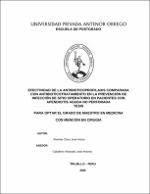Efectividad de la antibioticoprofilaxis comparada con antibioticotratamiento en la prevención de infección de sitio operatorio en pacientes con apendicitis aguda no perforada

View/
Download
(application/pdf: 389.8Kb)
(application/pdf: 389.8Kb)
Date
2020Author(s)
Rivertte Chico, José Arturo
Metadata
Show full item recordAbstract
Demostrar que la efectividad de la antibioticoprofilaxis es comparable a la
del antibioticotratamiento en la prevención de la infección de sitio operatorio (ISO) en
pacientes operados de apendicitis aguda no perforada.
Material y Método: Estudio observacional, analítico, de cohorte y prospectivo en
pacientes operados de apendicitis aguda no perforada en el Hospital Belén de Trujillo
entre setiembre del 2018 y abril del 2019.
Sesenta pacientes fueron divididos en dos grupos de 30 personas. Los pacientes del
grupo A recibieron un día la terapia combinada de ceftriaxona y metronidazol
endovenoso (antibioticoprofilaxis), mientras que los del Grupo B, recibieron durante
dicha hospitalización el mismo tratamiento y al alta ciprofloxacino y metronidazol
vía oral hasta completar 5 días de tratamiento antibiótico (antibioticotratamiento), de
acuerdo al criterio del médico de visita. A los pacientes de ambos grupos se les hizo
seguimiento durante 30 días para evaluar la presentación de ISO.
Resultados: Ambos grupos fueron comparables en las características iniciales. Los
resultados reflejan un mayor porcentaje de ISO en el grupo A con 13.33% en relación
al grupo B con 10% de presentación. Estos resultados no fueron estadísticamente
significativos (valor p = 0.69).
Conclusión: El uso de antibioticoprofilaxis es tan efectivo como el del
antibioticotratamiento en la prevención de ISO en pacientes operados de apendicitis
aguda no perforada. El uso de antibioticotratamiento no redujo la presentación de
ISO; al contrario, la aumentó. Los antibióticos postoperatorios aumentan el costo del
tratamiento y la estancia hospitalaria sin agregar un beneficio To demonstrate that the effectiveness of antibiotic prophylaxis is
comparable to antibiotic treatment in the prevention of surgical site infection (SSI) in
patients operated for acute non-perforated appendicitis.
Methods: Observational, analytical, cohort and prospective study in patients operated
on acute non-perforated appendicitis at the Hospital Belén de Trujillo between
September 2018 and April 2019. Sixty patients were divided in two groups of thirty
each. Patients in group A had one day of combined therapy of ceftriaxone and
intravenous metronidazole (antibiotic prophylaxis), while those in group B received
the same treatment during their hospital stay and after discharge, ciprofloxacin and
oral metronidazole until completing 5 days of antibiotic treatment (antibiotic
treatment), according to the criteria of the visiting doctor. Patients of both groups
were followed up for 30 days to evaluate the presentation of SSI.
Results: Both groups were comparable in initial characteristics. The results reflect a
mayor percentage of SSI in group A with 13.33% compared to group B with 10%
presentation. These results were not statistically significant (p value = 0.69).
Conclusion: The use of antibiotic prophylaxis is as effective as antibiotic treatment
in the prevention of SSI in patients operated on for acute non-perforated appendicitis.
The use of antibiotic treatment did not reduce the presentation of SSI; on the contrary,
it increased them. Postoperative antibiotics increased the cost of the treatment and the
hospital stay without adding a clinical benefit

